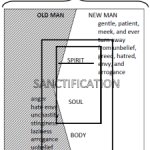Oposition to the doctrine of theosis among Lutherans seems to be rooted in the fear that it’s an alternate explanation for how we are saved, that it’s somehow in competition with justification through faith alone. And the way it’s usually presented by the Eastern Orthodox, it is, but that’s deeply backwards. Divinization is not a present reality that wins us future glory. Divinization is the future glory. It’s the end product, it’s the telos. Theosis is glorification.
I have never seen a Lutheran deny glorification. I don’t think I’ve seen a Christian of any stripe deny it, though I haven’t heard it talked about all that much either. The Resurrection of the righteous involves an ontological change—a change in human nature. “we know that when he appears we shall be like him, because we shall see him as he is” (I Jn. 3:2b). At present we are mortal, corruptible, and sinful. In the life of the world to come we will be immortal, incorruptible, and sinless. We will in fact be unable to sin. “And so shall we ever be with the Lord” (I Thess. 4:17b)—a promise that could not hold if a second Fall were conceivable. In the heavenly state, the cycle of sin and repentance will be broken. Sin will be no more possible than death. “But nothing unclean will ever enter , nor anyone who does what is detestable or false” (Rev. 21:27a).
St. Paul lays it out for us in Romans 8:29-30, complete with an ordo salutis (order of salvation):
For those whom he foreknew he also predestined to be conformed to the image of his Son, in order that he might be the firstborn among many brothers. And those whom he predestined he also called, and those whom he called he also justified, and those whom he justified he also glorified.
From this we learn two things crucial to the point I am making. First, we are not simply predestined to eternal life and eternal happiness, but eternal perfect Christlikeness. The end of the Christian life is “to be conformed to the image of His Son.” Second, the last step in the ordo is to be “glorified.” So it follows that glorification is the full measure, the completion, of our conformation to Christ. What does it mean to be glorified? It means to be made definitively, perfectly like Christ.
Christ is God. This is theosis. Notice, we do not become Christ; we become images of Christ. Christ is “the Image of the Invisible God” (Col. 1:15a), and we are in turn His images. “Just as we have borne the image of the man of dust, we shall also bear the image of the man of heaven” (I Cor. 15:49). We do not lose our human identity, but we do transcend the limitations proper to human nature. “For the trumpet will sound, and the dead will be raised imperishable, and we shall be changed. For this perishable body must put on the imperishable, and this mortal body must put on immortality” (I Cor. 15:52b-53). I think it is clear that this is what St. Peter means by becom[ing] partakers of the divine nature” (2 Pet. 1:4). It is, at any rate, what the Church Fathers meant when they spoke of divinization.
Theosis is glorification. It’s what happens at the Resurrection, the Beatific Vision. I am genuinely curious to know if any of the Lutherans I have been recently debating, or anyone else who opposes the doctrine of theosis, can object to this equation.
So what about the present? Is it proper to speak of divinization as a present reality, and not just a future one? Yes it is, because we have received the Holy Spirit. The first 28 verses of Romans 8, leading up to the ordo I quoted above, are all about the Holy Spirit and His work in the Christian, and one thing is clear: since we have the Spirit, we already have the life of the world to come—not full-grown yet, but in embryo:
But if Christ is in you, although the body is dead because of sin, the Spirit is life because of righteousness. If the Spirit of him who raised Jesus from the dead dwells in you, he who raised Christ Jesus from the dead will also give life to your mortal bodies through his Spirit who dwells in you. (v. 11)
We will be raised on the Last Day through the very Spirit that dwells in us right now. That’s why the Spirit is called “the down-payment of our inheritance” in Eph. 1:14. He’s like a cash advance, except that the currency is life and holiness, because He is the Holy Spirit, “the Lord, the Giver of Life” (Nicene Creed). What we have in Him is exactly what we’ll have in the Resurrection; we just have not been perfectly conformed to it yet. The difference between the holiness and life of the Church Militant, and the holiness and life of the Church Triumphant—that is to say, between sanctification and glorification—is not qualitative, but quantitative. The one is a process, the other is perfection. That’s why St. Paul left “sanctification” out of his ordo in Rom. 8: because “glorification” includes it, the way the full includes the partial. And no, this doesn’t mean that you work your way up the ladder until you get to God, as in Papist synergy, because the process ends at death. There’s no Purgatory to continue it. According to Scripture, the perfection is granted instantaneously, when we rise with Christ. The vast gap between His perfect image and your actual status at death will be obliterated “in a moment, in the twinkling of an eye, at the last trumpet” (I Cor. 15:52a).
This is why justification through faith alone is the paramount doctrine for this life, because “what we will be has not yet appeared,” even though it’s true that “we are God’s children now” (I Jn. 3:2). So we have to take it on faith that we are, and that it will—not because of our own merits, present or future, but only through the righteousness of Christ, received through faith.
If any of this stuff re: the relationships among justification, sanctification, and glorification sounds strange or non-Lutheran, it shouldn’t. This is what the Formula of Concord teaches.
In like manner also renewal and sanctification, although it is also a benefit of the Mediator, Christ, and a work of the Holy Ghost, does not belong in the article or affair of justification before God, but follows the same since, on account of our corrupt flesh, it is not entirely perfect and complete in this life, (SD III.28)
It is also correctly said that believers who in Christ through faith have been justified, have in this life first the imputed righteousness of faith, and then also the incipient righteousness of the new obedience or of good works. But these two must not be mingled with one another or be both injected at the same time into the article of justification by faith before God. For since this incipient righteousness or renewal in us is incomplete and impure in this life because of the flesh, the person cannot stand with and by it before God’s tribunal, but before God’s tribunal only the righteousness of the obedience, suffering, and death of Christ, which is imputed to faith, can stand, so that only for the sake of this obedience is the person (even after his renewal, when he has already many good works and lives the best life) pleasing and acceptable to God, and is received into adoption and heirship of eternal life. (SD III.32)
So here is my conclusion.
1) Theosis is glorification.
2) Sanctification is incipient glorification.
3) Therefore sanctification is incipient theosis.











